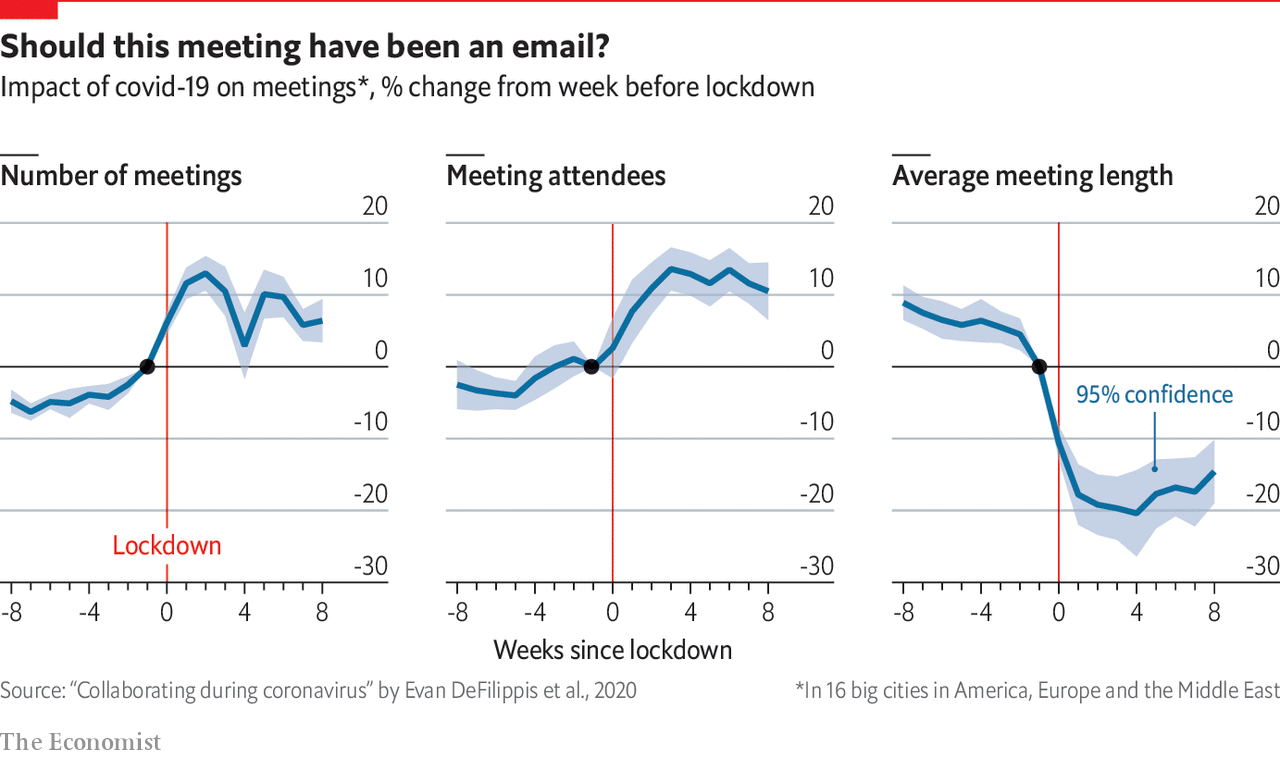How has the pandemic changed working lives?

Source: Economist
I was having a conversation over Facetime with one of my colleagues yesterday about what has — and has not — changed since the pandemic WFH experience has begun.
The mere fact that we were Facetiming is one indicia of change. Pre-lockdown, Facetime was an intrusive annoyance best left to grandparents saying hello to their grandkids. That no longer seems to be the case.
Recall back in June I pushed back against the “This changes everything” meme by pointing out that much of the changes we have seen were merely accelerations of prior trends rather than brand new innovations. E.G., video chatting, remote work, screen shares (And brick & mortar retail apocalypse) all have been around since the 2000s or longer.
The biggest surprise to many firms is how productive remote workers have been. Less commuting times, but more emails, calls and meetings. Will that attenuate, or is that a permanents condition? What will change over the next 6 months to a year?
One of the points made in that earlier post was that often, “We lack the imagination to recognize genuine change.” For the most part, we could not imagine pre-pandemic how the world would adapt and change during a lockdown. The challenge now from the middle of that WFH/lockdown is imagining what changes stick and what reverts back to normal when the vaccine, treatment, and herd immunity arrive.
Example: About a decade ago, I started WFH during summer Fridays. 2 years pre-pandemic, that expanded to year round. My 5 day a week, 40 weeks a year commute + 10 weeks at 4 days became 4 days a week, 50 weeks a year (+ vacay). What will life be like afterwards? Will we return to the office 4/5 days a week, including the commute, shaving and office garb versus unshowered pajama-wearing work?
A year ago, we kicked around the issue of when we might need to add another floor to the single floor, 5,000 feet we have on Bryant Park. Now, we can probably add a dozen new employees in the same space.
Here is the greatest challenge of this entire mental exercise:
What are we wrong about now?
In our imaginings of how much life and work will return to normal once we are past all of this, do we really have a firm handle on how we will feel in 2022? People are notoriously bad at this guessing game. We cannot predict what will make us happy, especially around issues of involving money. Should we imagine we know how we will feel once this is over?
It was so difficult to guess what life during the pandemic was going to be like — recall the genuine panic of February and March 2020, and how quickly we forgot about it. The question now under consideration is what will genuinely change if and when the world mean reverts.
The chart above is from the Economist; here is part of what they have to say:
“IN THE FUTURE, entire treatises may be written on how the covid-19 pandemic transformed the nature of work. As millions of employees have relocated to living rooms and kitchen tables, pundits are already touting the death of the office, a new era of flexible timetables and mass exoduses from cities. Whether these sweeping predictions prove true remains to be seen. Meanwhile workers’ daily routines have changed in many small-scale, mundane ways. They do not add up to a golden age of white-collar liberation.”
Short answer: No one knows . . .
Previously:
How Much Has the World Changed? Not much (June 16, 2020)
Hindsight Bias Free for All (May 27, 2020)
How Externalities Affect Systems (August 14, 2020)
How Technology Moves From Disruption to Invisibility (August 31, 2020)

